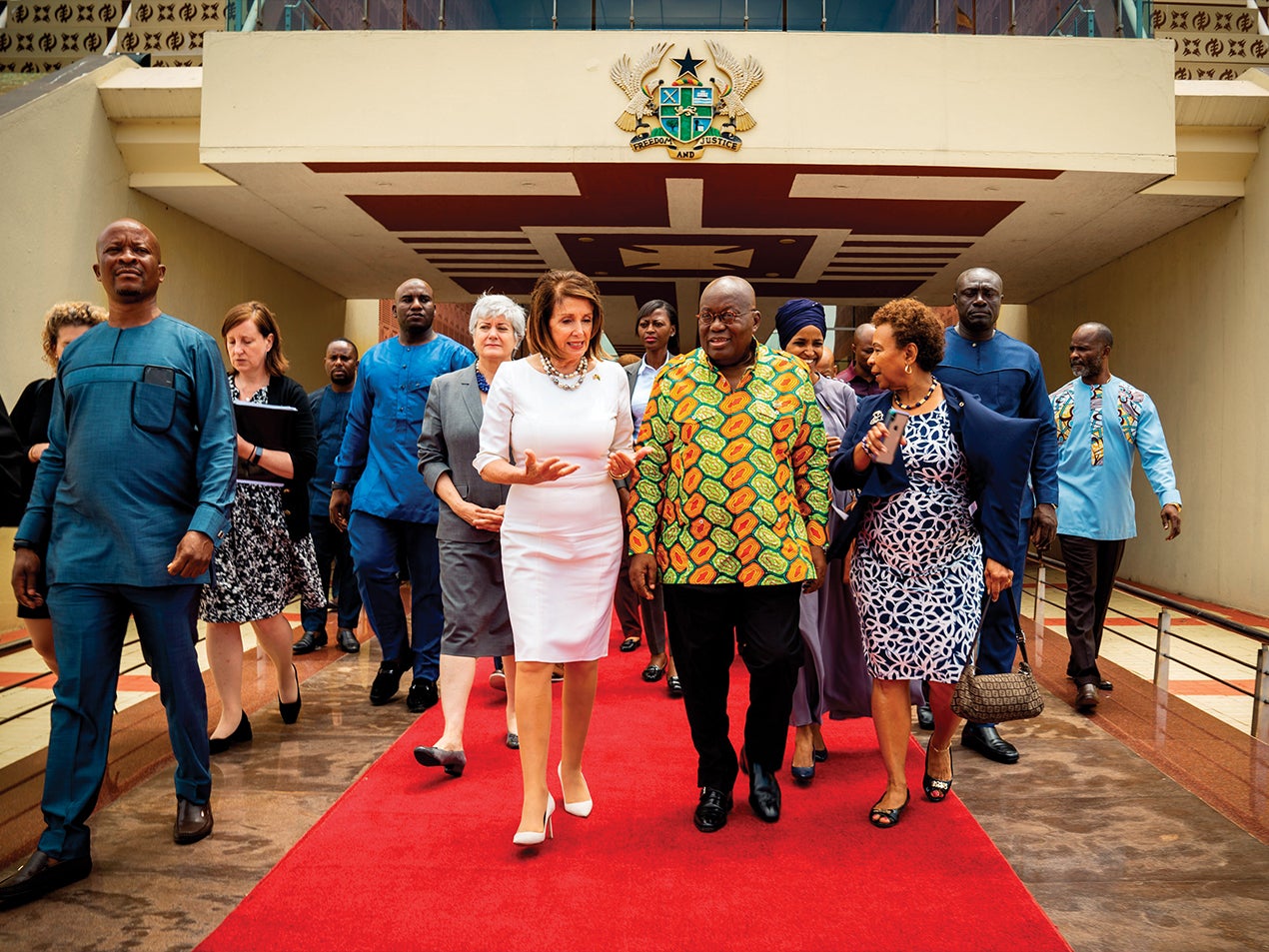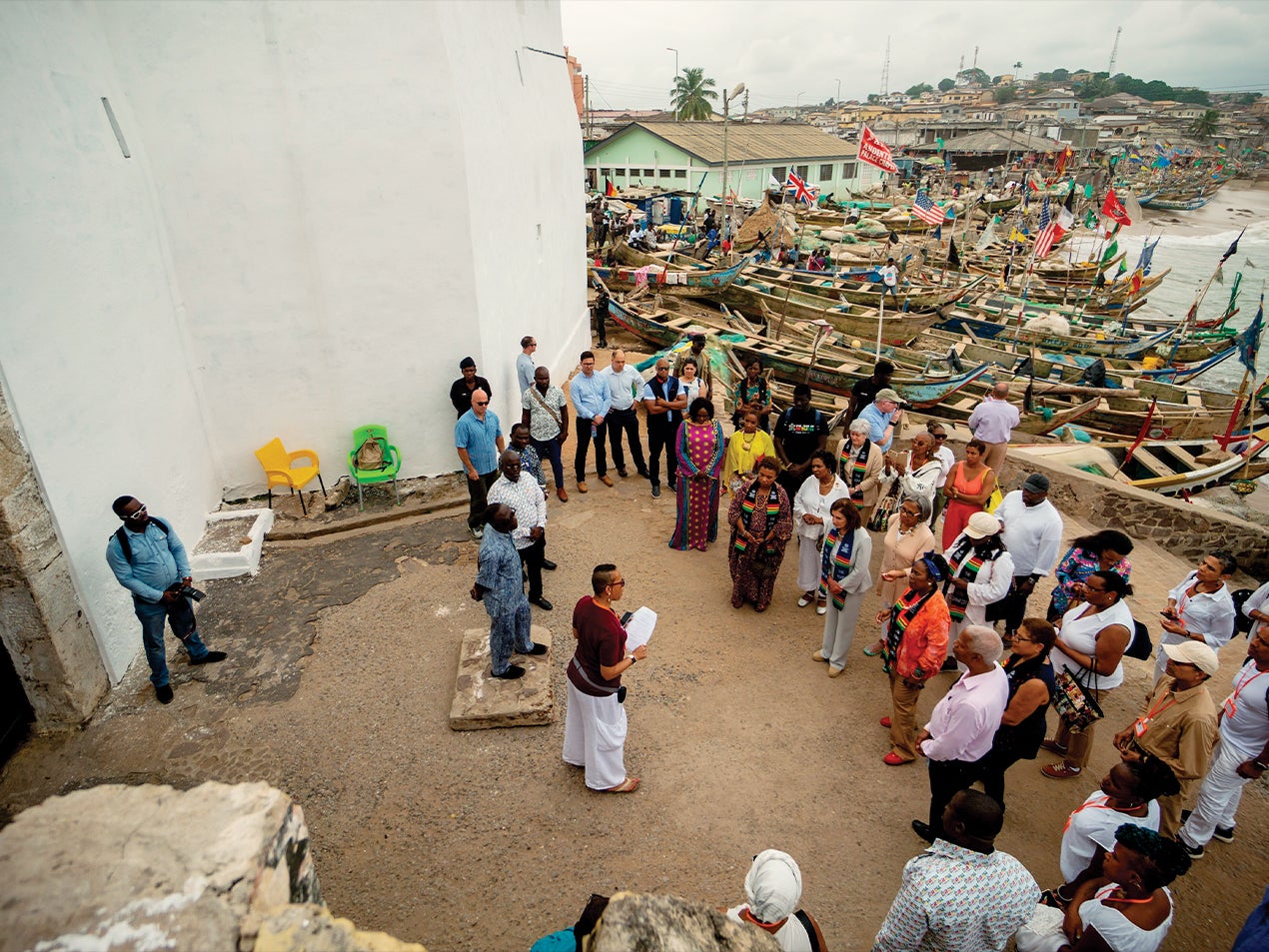
Angela landed in the Virginia Colony in the sweltering summer of 1619, after being brutally snatched from her native Africa. Along with other Africans, she was held captive in the bowels of a boat bound for a strange new land. That crossing, some 10,000 nautical miles that became known as the Middle Passage, was harrowing. It would establish the race-based system of bondage that led to 246 years of slavery in America.
Now, 400 years later, the nation is honoring, with commemorative events around the country and in Africa, the ancestors whose painful yet courageous legacy lingers. “Imagine being chained to the holds [of these ships], where there is nowhere to go to the bathroom,” says Robert Trent Vinson, Ph.D., professor of history and Africana studies at William & Mary University in Williamsburg, Virginia. “Imagine being on an ocean for the first time, dealing with seasickness and having to wallow in your excrement and vomit. And in the age of sail, that journey could take months.”

Yet even before the Middle Passage, Angela and her fellow Africans were treated as human cargo, enduring physical and emotional trauma. “They were kidnapped in a series of incursions the Portuguese were waging against the African kingdoms of Kongo and Ndongo—current day Angola—and surrounding kingdoms,” says Cassandra Newby-Alexander, Ph.D., dean of the College of Liberal Arts at Norfolk State University.
“The Portuguese wanted gold, and they wanted people.” European forces and the Imbangala—marauding African mercenaries—were among those who played roles in the transatlantic slave trade. “The captives had to march hundreds of miles to the coastal town of Luanda,” the historian adds. “The capital of Angola was a major slave trade port.” About 350 JULIO OBSCURA Africans were forced to board the San Juan Bautista, a Portuguese slave ship.
Bound for Veracruz, on the coast of Mexico, it stopped in Jamaica, selling dozens of children. As the vessel neared its destination, it was attacked in the Gulf of Mexico by two English ships, the White Lion and the Treasurer. The privateers might have been expecting gold when they boarded; instead, they discovered the Africans and stole approximately 60 of them. Both boats then headed for the Virginia Colony, with the White Lion arriving in late August.
We are the descendants of Black women, who chose to survive.
-ÑKARSONYA WISE WHITEHEAD
Some historians cite the date as August 20, 1619, while others put it as August 25. “It landed at Point Comfort, Virginia,” says Mary Elliott, curator of American slavery at the Smithsonian’s National Museum of African American History & Culture. The site, in present day Hampton, Virginia, is now Fort Monroe National Monument. Records from Virginia Colony secretary John Rolfe, who was formerly married to the Native American princess Pocahontas, indicate that “20 and odd Negroes” were exchanged for food.
They were the first in this area. African slaves had been brought to the Spanish colonies in North America as early as the 1500’s. Many more would follow. “Angela and approximately 28 captives arrived on the Treasurer four days later,” Vinson says. “The ship remained briefly before setting sail for the English colony of Bermuda, where most were sold, including Angela.”
He notes that a few months later, in February 1620, Angela and a handful of other enslaved Africans were brought back to Virginia aboard the Treasurer: “She and her fellow captives from West Central Africa were most, if not all, of the 32 Africans recorded in Virginia’s May 1620 census.” The captive humans on those ships— whose Christian names, such as William, Frances, Margaret, John and Edward, would have been given to them by Portuguese missionaries in Africa— would be the “founding” mothers and fathers of millions of African-American descendants and would dramatically alter the course of history.
The Virginia Colony, which began as the Jamestown settlement, was founded in 1607. As England’s first permanent colony in North America, it was where the fledgling United States of America took root. “You have the meeting of the House of Burgesses, which is the first Democratic government,” says Elliott.
When these White male landowners convened in 1619, the representatives sought to provide “just laws for the happy guiding and governing of the people there inhabiting.” Yet the cruel irony of Africans in servitude made the reality far from happy. “We need to remember that our ancient culture hails from countries and civilizations where love was expressed and taught through socialization,” says Colita Nichols Fairfax, Ph.D., a professor, historiographer and member of the Association for the Study of African American Life and History, which was established in 1915 by the father of Black history, Carter G. Woodson.

“When Africans were forced onto the White Lion, they landed in socioeconomic environs that disrupted traditions and socialization practices.” Records suggest most of the early Africans were acquired by wealthy English planters and colonial officials. Angela was listed in a seventeenthcentury colony-wide census as living in the household of Captain William Peirce, a prosperous planter and merchant.
“Angela was the first African woman documented in the Virginia Colony, though her name was listed as Angelo,” says Newby-Alexander. “She was referred to as ‘that Negro woman who raised pigs,’ even though Angela was probably helping Peirce’s wife, Joane, maintain a four-acre garden.”
Another early African couple was Isabella and Anthony. They were servants of Captain William Tucker, a military commander, and by 1625 they had had a son, William. It’s believed he was surnamed for Captain Tucker, who, it’s said, stood as his godfather. William Tucker is recognized as the first identified child of African parents baptized in Jamestown. Carolita Jones Cope, 60, and her family believe they are his descendants on her mother’s side.
While the clan doesn’t have definitive proof, members cite genealogical research and oral traditions. Relatives traveled to Hampton in August to pay tribute to the ancestors at the Tucker Family Cemetery, which dates back to 1896. “We’re a symbol of all who pushed through and survived slavery,” says Cope. “It shows how strong a people we are.”
The Tucker family gathering dovetailed with the 2019 Commemoration of the First African Landing in Hampton, hosted by the Hampton VA 2019 Commemorative Commission with the Fort Monroe Authority, the city of Hampton and a handful of local partners.
From a sunrise African naming ceremony and spiritual cleansing on the beach to a concert with rapper and actor Common and Sounds of Blackness, the events drew dignitaries, celebrities and several thousand people from across the country and the world who paid homage with prayers and tears. About a dozen members of the Congressional Black Caucus, along with House Speaker Nancy Pelosi, also traveled to Ghana to mark the 1619 historical event. Susan L. Taylor, editor-inchief emerita of ESSENCE magazine and founder and CEO of the National CARES Mentoring Movement, along with her family, joined the trip.
The NAACP led a large delegation to Ghana this summer as well. Both delegations met with Ghanaian government officials and paid their respects at Cape Coast and Elmina castles, where captives were kept before the sea voyage, and at the Door of No Return, from which they boarded the slave ships. From 1501 to 1867, nearly 13 million people from the African continent were captured, sold and transported to the Americas. Portugal, Spain, England, France and America were among the countries that made lucrative profits from selling human beings.

Despite the cruelties of bondage, early Africans adapted to their new environment while holding on to certain customs. “They infused America with art, music, culinary practices, trading systems, agricultural and architectural techniques and language,” says Newby-Alexander. “The landing of the first recorded Africans in 1619 marked the moment African culture became an integral part of American culture and an indelible influence on the development of our nation.”
After 1625 Angela no longer appeared in the census. The Jamestown Rediscovery Foundation, in partnership with the National Park Service, excavated the property of Peirce, her owner. Archaeologists sought to uncover evidence of the house, outbuildings, gardens and artifacts that could shed light on the household’s activities, diet and occupants.
While Angela would not have had many possessions, experts believe her presence can still be understood through subtle clues in the archaeological record. Karsonya Wise Whitehead, Ph.D., an author, a radio host and an associate professor at Loyola University Maryland, observes that stories of women like Angela are routinely left out of the dominant narrative about early American history.
“There is a sense that since Black women were assumed to be a part of the background, they did not have a hand or a voice in the creation of our nation,” she says. “We do know that their very existence was an important act of agency and survival [despite] continuous rape, oppression, violence and abuse.
“We are the descendants of Black women, our foremothers, who chose to survive and go forward rather than go backward,” she adds, noting that their revolutionary acts and relentless fight for freedom should make us proud.
